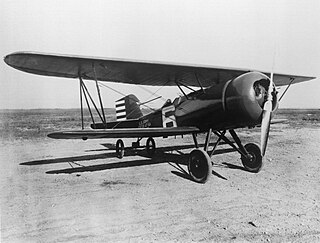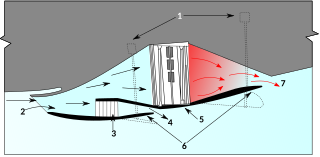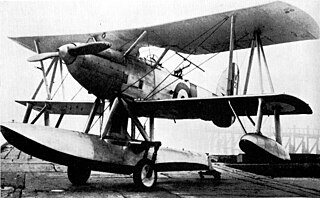
A Townend ring is a narrow-chord cowling ring fitted around the cylinders of an aircraft radial engine to reduce drag and improve cooling. It was patented in 1929, and found use on various aircraft of the 1930s and into the 1940s.

A Townend ring is a narrow-chord cowling ring fitted around the cylinders of an aircraft radial engine to reduce drag and improve cooling. It was patented in 1929, and found use on various aircraft of the 1930s and into the 1940s.

The Townend ring was the invention of Dr. Hubert Townend of the British National Physical Laboratory [1] in 1929. Patents were supported by Boulton & Paul Ltd in 1929. [2] [3] In the United States it was often called a "drag ring". It caused a reduction in the drag of radial engines and was widely used in high-speed designs of 1930–1935, before the long-chord NACA cowling came into general use. Despite suggestions of it exploiting the Meredith effect, low airspeeds, low temperature differences and small mass flows make that unlikely, [4] particularly when combined with the lack of flow control as the air exits the cowling. [5] Although superior to earlier cowlings, and uncowled engines in terms of drag and cooling, above 217 kn (402 km/h; 250 mph) the NACA cowling was more efficient and soon replaced it in general use. [6] [ failed verification ]

Examples of aircraft with Townend rings include the Boeing P-26 Peashooter, the Vickers Wellesley, the Fokker D.XVI and the central engine on the Junkers Ju 52/3m. [lower-roman 1]

The Whitcomb area rule, named after NACA engineer Richard Whitcomb and also called the transonic area rule, is a design procedure used to reduce an aircraft's drag at transonic speeds which occur between about Mach 0.75 and 1.2. For supersonic speeds a different procedure called the supersonic area rule, developed by NACA aerodynamicist Robert Jones, is used.

The radial engine is a reciprocating type internal combustion engine configuration in which the cylinders "radiate" outward from a central crankcase like the spokes of a wheel. It resembles a stylized star when viewed from the front, and is called a "star engine" in some other languages.

The BMW 801 was a powerful German 41.8-litre (2,550 cu in) air-cooled 14-cylinder-radial aircraft engine built by BMW and used in a number of German Luftwaffe aircraft of World War II. Production versions of the twin-row engine generated between 1,560 and 2,000 PS. It was the most produced radial engine of Germany in World War II with more than 61,000 built.

The Junkers Ju 52/3m is a transport aircraft that was designed and manufactured by German aviation company Junkers. First introduced during 1930 as a civilian airliner, it was adapted into a military transport aircraft by Germany's Nazi regime, who exercised power over the company, for its war efforts over the objections of the company's founder Hugo Junkers.

The NACA cowling is a type of aerodynamic fairing used to streamline radial engines installed on airplanes. It was developed by Fred Weick of the National Advisory Committee for Aeronautics (NACA) in 1927. It was a major advance in aerodynamic drag reduction, and paid for its development and installation costs many times over due to the gains in fuel efficiency that it enabled.

A cowling is the removable covering of a vehicle's engine, most often found on automobiles, motorcycles, airplanes, and on outboard boat motors. On airplanes, cowlings are used to reduce drag and to cool the engine. On boats, cowlings are a cover for an outboard motor. In addition to protecting the engine, outboard motor cowlings need to admit air while keeping water out of the air intake.

The Lioré et Olivier LeO H.242 was a monoplane flying boat aircraft designed and produced by the French aircraft manufacturer Lioré et Olivier. It was used for European passenger air services in the 1930s, including by the flag carrier Air France. One LeO H.242 was depicted near the end of Hergé's The Adventures of Tintin comic King Ottokar's Sceptre.

The Boeing P-29 and XF7B-1 were an attempt to produce a more advanced version of the highly successful P-26. Although slight gains were made in performance, the U.S. Army Air Corps and U.S. Navy did not order the aircraft.

The Dewoitine D.332 was an eight-passenger airliner designed and built by the French aircraft manufacturer Dewoitine.

The Wibault 280-T was a monoplane trimotor airliner designed and produced by the French aircraft manufacturer Wibault. Designed to accommodate up to 12 passengers in its largest variant, development of the aircraft was financially backed by the Penhoët shipyards, which led to the aircraft alternatively being referred to as 'Penhoët Wibault'.

The Fokker D.XVI was a sesquiplane fighter aircraft developed in the Netherlands in the late 1920s.

The Rearwin Sportster is a 1930s American two-seat, high-winged, cabin monoplane designed and built by Rearwin Aircraft & Engines for sport/touring use.
The Bristol Type 92, sometimes known as the Laboratory biplane, was an aircraft built by the Bristol Aeroplane Company to address the differences between wind tunnel cowling models and full scale cowling for radial engines and was designed as a scaled-up version of a wind tunnel model aircraft. One was built and flew in the mid-1920s.

The Bristol Type 133 was a single-seat, single-engine monoplane fighter armed with four guns, using stressed-skin construction and with a retractable undercarriage. It was built by The Bristol Aeroplane Co. to meet Specification F.7/30. The single example crashed before the trials commenced.

The Meredith effect is a phenomenon whereby the aerodynamic drag produced by a cooling radiator may be offset by careful design of the cooling duct such that useful thrust is produced by the expansion of the hot air in the duct. The effect was discovered in the 1930s and became more important as the speeds of piston-engined aircraft increased over the next decade.

The Vickers Type 151 Jockey was an experimental low-wing monoplane interceptor fighter powered by a radial engine. It was later modified into the Type 171 Jockey II, which had a more powerful engine and detail improvements. Only one was built; it was lost before its development was complete, but the knowledge gained enabled Vickers to produce the more refined Venom.

The Short Gurnard was a single-engined two-seat biplane naval fighter, built in the United Kingdom to an Air Ministry specification in 1929. It failed to win production orders and only two flew.

The Lorraine Hanriot LH.41 was a single-seat racing aircraft designed and built in France specifically to compete in the Coupe Michelin air races, held in France.

The Propeller Research Tunnel (PRT) was the first full-scale wind tunnel at the National Advisory Committee for Aeronautics (NACA) Langley Research Center, and the third at the facility. It was in use between 1927 and 1950 and was instrumental in the drag reduction research of early American aeronautics. In 1929, NACA was awarded its first Collier Trophy for the NACA cowling which was tested and developed using the Propeller Research Tunnel.

The Zenith Z-6 is a single engine biplane U.S. airliner built in the late 1920s. Its cabin, in the fuselage immediately behind its radial engine, holds five or six passengers depending on engine power. It is flown from an open cockpit further aft. Nine were completed and one has been restored to flight.